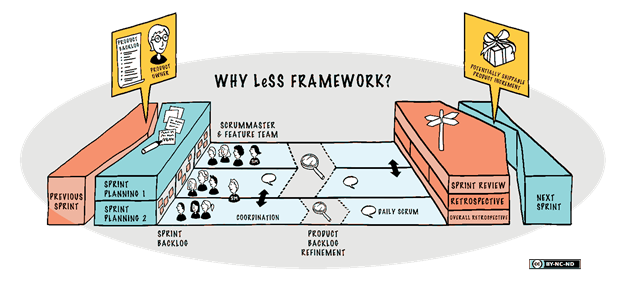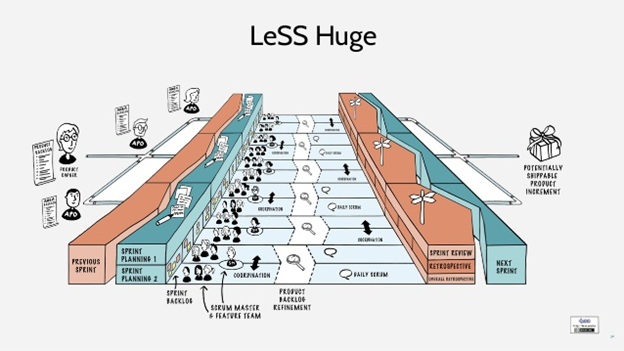LeSS is a lightweight, Agile framework for scaling Scrum to more than one team. Starting in 2005 Bas Vodde and Craig Larman developed the LeSS framework after using Scrum principles and rules on large scale projects. Their goal was to develop large scale projects successfully while staying within the constraints of Scrum.
LeSS builds on top of the Scrum principles such as empiricism, cross-functional self-managing teams and provides a framework for applying that at scale. It provides simple structural rules, guides, and experiments on how to adopt Scrum in the large-scale product development environment. LeSS has only a few rules and two frameworks: LeSS and LeSS Huge.
- LeSS Basic: 2–8 Teams
- LeSS Huge: 8+ Teams
The difference lies in the size of total teams involved. Basic LeSS is two to eight teams of eight each working on the same product development. LeSS Huge is up to 2,000 plus people working on the same product development. In other words, how big would you like large to be? LeSS can scale scrum up or down to work in many environments.
LeSS framework
The Figure below illustrates the LeSS basic framework. The number of development teams varies from two to eight. One product owner covers up to eight teams and each scrum master serves up to three teams.

In the LeSS framework, there is one product owner and one product backlog for the complete shippable product. The product owner shouldn’t work alone on product backlog refinement; she is supported by the multiple development teams that are working directly with customers/users and other stakeholders. All prioritization goes through the product owner, but clarification can happen directly between the teams and customer/users and other stakeholders.
While much of LeSS remains true to the one-team scrum framework, the differences are important:
- Sprint Planning is split into two parts: Part 1 is common for all teams and Part 2 is for each team.
- Sprint planning (Part 1) is limited to one hour per week of sprint length. Although not all developers are required to attend, they aren’t discouraged, and at least two members per sprint team attend, along with the product owner. The representative team members then go back and share their information with their respective teams.
- Independent sprint planning (Part 2) and daily scrums occur, and members from different teams can attend each other’s meeting to facilitate information sharing.
- Cross-team coordination is decided by the teams with a preference to decentralized and informal coordination over centralized coordination. The emphasis is on informal networks that involve cross-team talking, component mentors, travelers, scouts, and open spaces.
- Backlog refinement is done for the overall product backlog with representatives from each development team and the product owner. Individual team backlog refinement also takes place at the individual team level but multi-team backlog refinement happens every sprint and is the key practice in LeSS.
- Sprint reviews are done with representatives from each team and the product owner.
Scrum vs LeSS Framework
Basic LeSS is very similar to a one team Scrum, only extended. In LeSS there is one Product Backlog, one Product Owner, one Definition of Done, one common sprint, and one PSP (Potentially Shippable Product) increment at the end of the sprint. Since all teams are working on implementing the same product, all teams are cross-functional with few, if any, specialty teams. In summary, all teams work to deliver a common, shippable product each sprint.
There are differences in regular Scrum and LeSS. In LeSS, sprint planning is done separately in two meetings. In one meeting the Product Owner meets with representatives from all teams who manage among themselves to decide which product backlog items they will do in the next sprint. Some of the same work may be shared with two or more teams. The second meeting, held in parallel or shortly after the first, is a meeting of all the members of each team. For coordination purposes the team meetings may be held in different sections of the same area, but separately. This set-up is helpful when two teams who are doing work on the same tasks during the next sprint, might have questions or need clarification from the other team.
LeSS Huge framework
LeSS Huge builds on the LeSS framework by optimizing for eight or more teams. With LeSS Huge, the sky is the limit as far as overall project team size goes. A few thousand people could work on one project. LeSS Huge introduces several new concepts and challenges for managing large-scale backlogs. These are requirement areas, area product backlogs, and area product owners.
The scrum teams are divided into major customer requirement areas. Each area has one area product owner and four to eight scrum teams. (Having at least four teams in each requirement area prevents too much local optimization and complexity.) One overall product owner and several area product owners form the product owner team. The Figure below illustrates the LeSS Huge framework.

As in scrum and in smaller LeSS, you have one product, one definition of done, one (area) product owner, and one sprint. LeSS Huge is a stack of LeSS for each requirement area. Each requirement area uses LeSS, and the set of all requirement areas is in LeSS Huge. Some of the differences are
- A product owner planning meeting happens before the sprint planning meeting.
- Area-level meetings are added. Sprint planning, review, and retrospective meetings are done at the area level, and area-level product backlog refinement occurs.
- Overall sprint reviews and retrospectives involving all teams are done. This review coordinates the overall work and process across the product program area.
LeSS allows for the implementation of scrum and scaling in a way that for the most part holds true to Agile Principles. Some elements of the scrum framework are upheld with empirical learning, short feedback loops, self-organization, and effective collaboration and coordination.
Leadership tools also exist in LeSS for good decisions that maximize ROI; deliver value to customers; and create happy, sustainable teams.
LeSS Basic vs LeSS Huge
LeSS Huge is similar to Basic LeSS, except that due to size there are two or more Area Product Owners. The Area Product Owners and the one overall Product Owner make up the Product Owner team. Depending on size there may also be additional Product Managers.
Each requirement area has ideally four to eight teams. Since work done under Less Huge is usually multiple area teams of four to eight teams, and Basic LeSS is two to eight teams, the basic functioning of teams under Basic LeSS and LeSS Huge, is the same.
Manage Scrum with Large-Scale Scrum Canvas
Your team may use agile tool to automate the entire Agile Project management software using Visual Paradigm for maximizing Scrum project efficiency with a visual process canvas designed for large-scale projects.
Take a quick tour for Large Scrum Canvas — Manage your entire LeSS Framework in one single page.
Resources:

